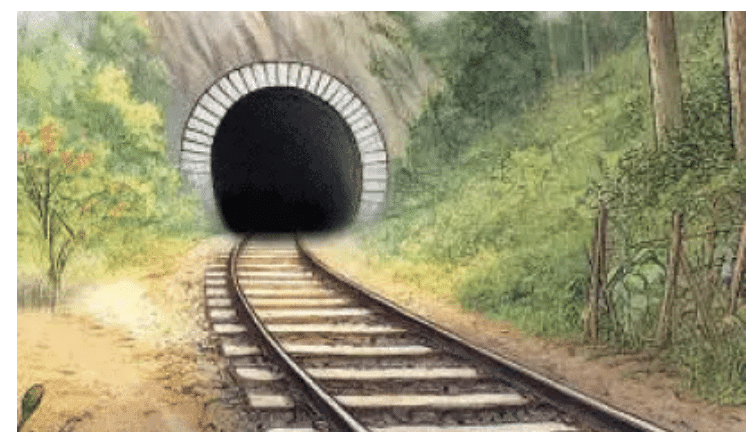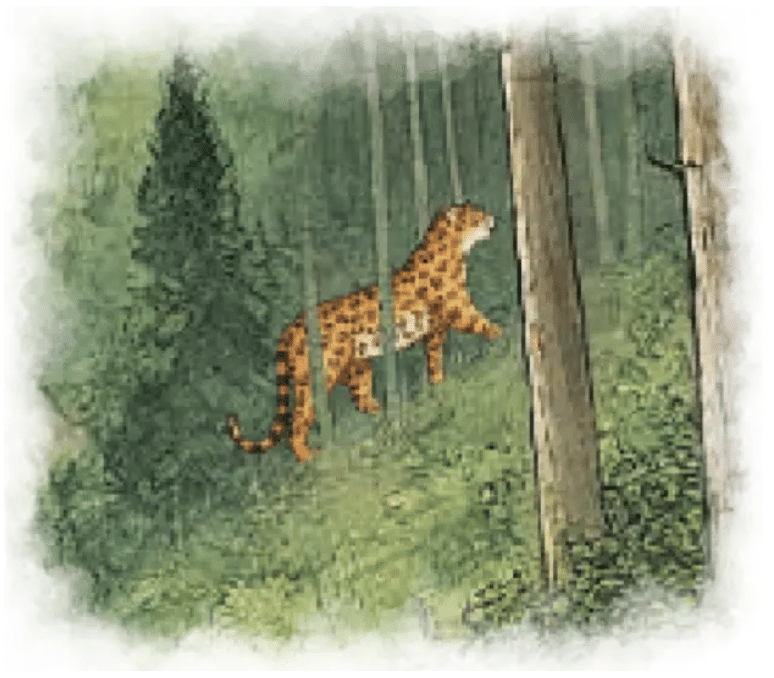Class 7 English Unit 4 Worksheet Solutions - The Tunnel
| Table of contents |

|
| Multiple Choice Questions (MCQs) |

|
| Fill in the Blank |

|
| True or False |

|
| Very Short Answer Questions |

|
| Long Answer Questions |

|
Multiple Choice Questions (MCQs)
Q1: Who is the author of “The Tunnel”?
a) Rabindranath Tagore
b) Ruskin Bond
c) Anita Rau Badami
d) G.C. Thornley
Ans: b) Ruskin Bond
The introduction clearly states that the story is written by Ruskin Bond.
Q2: Why does Suraj visit the railway tunnel?
a) To catch a train
b) To watch the steam train
c) To meet Sunder Singh
d) To find a leopard
Ans: b) To watch the steam train
Suraj visits the tunnel to watch the midday steam train burst out, as he finds it magical.

Q3: What does Sunder Singh use to signal trains at night?
a) A red flag
b) A whistle
c) An oil lamp
d) A torch
Ans: c) An oil lamp
Sunder Singh uses an oil lamp to signal trains at night, as mentioned in the story.
Q4: What animal do Suraj and Sunder Singh encounter in the tunnel?
a) A porcupine
b) A leopard
c) A bat
d) A lizard
Ans: b) A leopard
Suraj and Sunder Singh hear a sawing sound and encounter a leopard in the tunnel, which they scare away.
Q5: What does the word “plume” mean in the story?
a) A type of bird
b) A long, thin cloud
c) A railway track
d) A loud sound
Ans: b) A long, thin cloud
The word “plume” is defined as a long, thin cloud, like the smoke trailing behind the train.
Fill in the Blank
Q1: Suraj hides his _______ in a nearby village before walking to the tunnel.
Ans: bike
Q2: The steam train bursts out of the tunnel like a _______.
Ans: dragon
Q3: Sunder Singh’s job is to inspect the _______ for obstacles.
Ans: tunnel
Q4: Suraj sees a _______ light from Sunder Singh’s lamp when riding the night train.
Ans: flickering
Q5: The word “scuttled” means to run with _______ steps.
Ans: small
True or False
Q1: Suraj wants to catch the midday train to travel to town.
Ans: False
Suraj visits the tunnel to watch the train, not to catch it, as he loves its magical appearance.
Q2: Sunder Singh calls the leopard “his” because it visits the area often.
Ans: True
Sunder Singh refers to the leopard as “his” because it’s a familiar visitor to the area, as he explains to Suraj.

Q3: Suraj and Sunder Singh enter the tunnel to catch the leopard.
Ans: False
They enter the tunnel to scare the leopard away to protect it from the train, not to catch it.
Q4: The story teaches that courage can lead to new friendships.
Ans: True
Suraj’s bravery and curiosity lead to his friendship with Sunder Singh, aligning with the story’s moral.
Q5: The word “shisham” refers to a type of bird.
Ans: False
“Shisham” is a type of tree, not a bird, as defined in the story.
Very Short Answer Questions
Q1: What is the name of the tunnel’s watchman?
Ans: Sunder Singh
Q2: What does Suraj see on the hillside after leaving the tunnel?
Ans: A leopard’s tail
Q3: What sound alerts Suraj and Sunder Singh to the leopard in the tunnel?
Ans: Sawing sound
Q4: What is the meaning of the word “reassure” in the story?
Ans: To make someone feel calm
Q5: What is one moral of the story?
Ans: Courage leads to adventures
Long Answer Questions
Q1: How does Suraj’s fascination with the steam train set the stage for his adventure?
Ans: Suraj’s fascination with the steam train sparks his adventure as he rides his bike from town, hides it, and treks to the railway tunnel just to see the train emerge. His excitement over the train, which he imagines as a "green, black, and gold dragon," drives his curiosity to explore the tunnel. Inside, he discovers its damp, smoky atmosphere and encounters a bat and a lizard. This exploration leads him to Sunder Singh’s hut, where they become friends and have a thrilling encounter with a leopard. Suraj’s love for the train turns a simple outing into a series of unexpected adventures, showcasing his adventurous spirit.
Q2: Describe the relationship between Suraj and Sunder Singh and how it develops.
Ans: The relationship between Suraj and Sunder Singh starts when Suraj, intrigued by his tunnel exploration, meets the watchman at his hut. Sunder Singh greets him kindly, joking about "owning" the tunnel and sharing stories about the leopard, which creates an instant connection. Their bond grows when Suraj returns for the night adventure, where they share tea and face the leopard together, showing their trust and teamwork. Sunder Singh reassures Suraj and helps him feel safe, while Suraj's excitement and curiosity make him likable to the watchman. By the end of the story, their friendship is clear, with Suraj fondly remembering the lamp Sunder Singh showed him from the train, highlighting the deep connection they’ve formed through shared experiences and respect.
Q3: Explain the events in the tunnel when Suraj and Sunder Singh face the leopard.
Ans: When Suraj and Sunder Singh hear a sawing sound from the tunnel, signalling the presence of a leopard, they realize it could be in danger of being hit by the incoming night train. Concerned for the leopard's safety, Sunder Singh decides to scare it away, bringing an axe for protection and reassuring Suraj. Together, they enter the dark tunnel, using loud shouts and the glow of the oil lamp to startle the leopard. The leopard, described as agile and sleek, quickly flees into the jungle, its tail flicking as it escapes. They ensure the tracks are clear and step aside just as the train rushes by. Their actions highlight their courage and quick thinking, successfully protecting both the leopard and the train.
Q4: What is the moral of the story, and how do Suraj’s actions illustrate it?
Ans: The moral of the story is that courage and curiosity can lead to exciting adventures and unexpected friendships. Suraj’s curiosity about the steam train sparks his journey into the jungle tunnel, even though it’s dark and eerie. His bravery shines when he teams up with Sunder Singh to face the leopard, entering the tunnel to protect the animal despite the risks. These bold decisions lead to a thrilling adventure and the start of a meaningful friendship with Sunder Singh. Suraj’s willingness to step outside his comfort zone—from cycling to the jungle to confronting a wild animal—shows that embracing courage and curiosity can lead to rewarding experiences.
Q5: Discuss how the story uses the jungle and train to create a sense of thrill and wonder.
Ans: The story uses the jungle and the steam train to create a sense of thrill and wonder through vivid descriptions and exciting events. The jungle is depicted as a wild and vibrant place, with towering evergreen trees, scrub-covered hills, and wildlife like leopards and nightjars, sparking Suraj’s curiosity while adding an element of danger, especially during the leopard encounter. The steam train, described as a “snorting” and “puffing” dragon bursting from the tunnel, evokes awe with its power and sparks, shaking the jungle into life. The tunnel itself, dark and damp, adds to the thrill as Suraj explores it and faces the tense leopard situation. Together, the untamed jungle and the majestic train provide a backdrop of excitement and mystery, pulling readers into Suraj’s adventurous world and intensifying the story’s sense of wonder.
|
1 videos|107 docs
|
FAQs on Class 7 English Unit 4 Worksheet Solutions - The Tunnel
| 1. What is the main theme of "The Tunnel"? |  |
| 2. Who are the main characters in "The Tunnel"? |  |
| 3. What challenges do the characters face while exploring the tunnel? |  |
| 4. How does the tunnel symbolize growth and discovery in the story? |  |
| 5. What lessons can readers learn from "The Tunnel"? |  |















